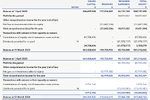I'm trying to improve my understanding of company financials.
How can a company payout all of it's net profit (& more!) as dividends (payout ratio > 100) and still increase shareholders equity? I notice the number of shares is increasing ("shares outstand"), but "other income" is (almost) zero, so it can't be capital raising, right?
Aside: the company is ASX:WHF.

How can a company payout all of it's net profit (& more!) as dividends (payout ratio > 100) and still increase shareholders equity? I notice the number of shares is increasing ("shares outstand"), but "other income" is (almost) zero, so it can't be capital raising, right?
Aside: the company is ASX:WHF.

Last edited:




